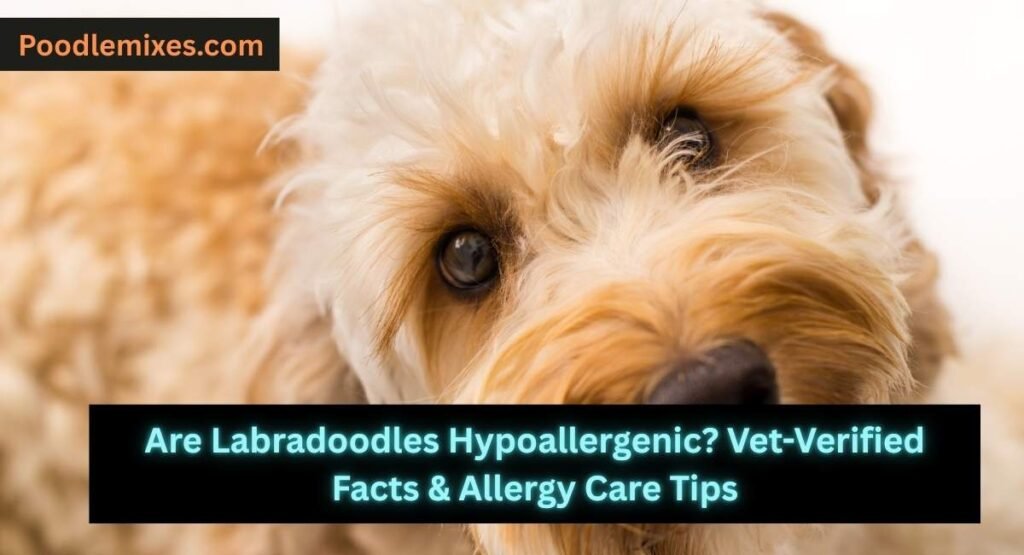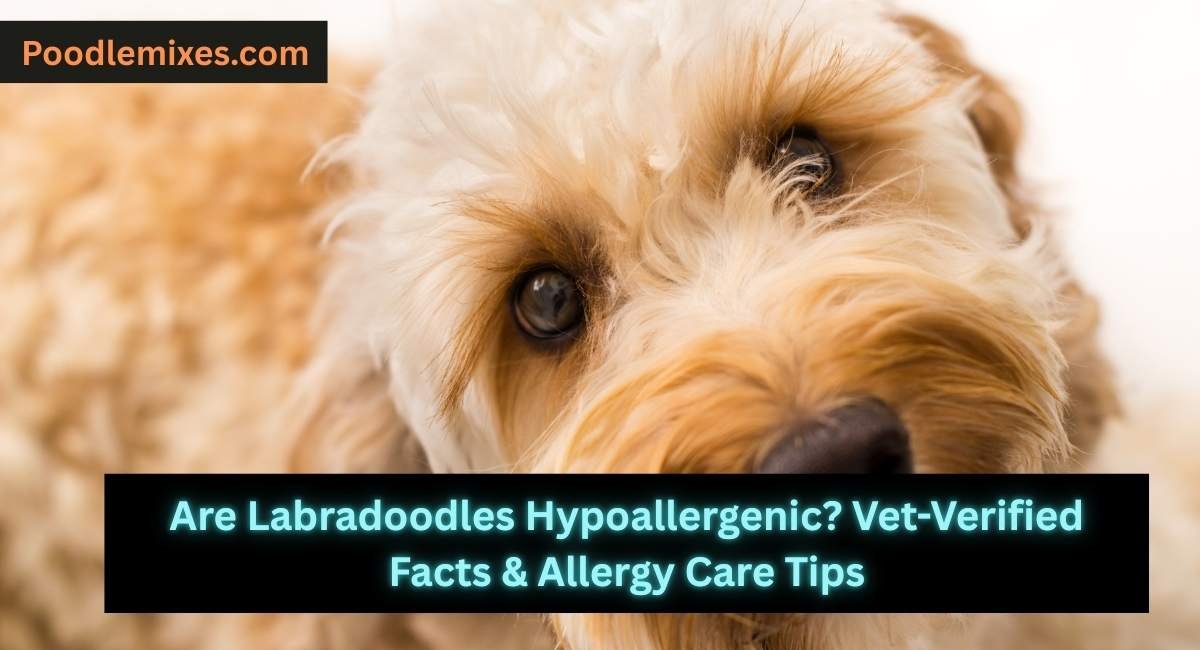Are Labradoodles hypoallergenic? This question is crucial for the millions of families affected by pet allergies who dream of welcoming a furry companion into their homes. According to the Asthma and Allergy Foundation of America (AAFA), approximately 10-20% of the global population suffers from pet allergies, making the search for hypoallergenic breeds a top priority for many prospective dog owners. The Labradoodle, a popular crossbreed between a Labrador Retriever and a Poodle, has gained significant attention as a potential solution for allergy sufferers seeking a loving, intelligent, and family-friendly pet.
What Does “Hypoallergenic” Mean?
The term “hypoallergenic” refers to breeds that are less likely to trigger allergic reactions in sensitive individuals. According to the American Kennel Club (AKC), no dog breed is 100% hypoallergenic, as all dogs produce allergens through their dander (dead skin cells), saliva, and urine. The primary allergen, Can f 1 protein, is present in all dogs regardless of breed.
Common myths about hypoallergenic dogs include the belief that short-haired dogs are always better for allergies or that non-shedding equals hypoallergenic. The AAFA clarifies that allergen levels vary significantly between individual dogs, even within the same breed, and that factors like grooming frequency and the dog’s living environment play crucial roles in allergen management.
About Labradoodles
Labradoodles originated in Australia during the 1980s when breeder Wally Conron first crossed a Labrador Retriever with a Standard Poodle to create a guide dog suitable for people with allergies. This designer breed combines the Labrador’s friendly, trainable nature with the Poodle’s intelligence and low-shedding coat.
Labradoodles typically exhibit three coat types: hair (similar to Labradors), fleece (soft and wavy), and wool (tight curls like Poodles). Their temperament is generally friendly, energetic, and highly social, making them excellent family pets. The breed’s shedding levels vary significantly depending on their generation (F1, F1B, F2) and coat type, with wool and fleece coats typically shedding less than hair coats.

Are Labradoodles Hypoallergenic?
Veterinary experts and allergy specialists provide a nuanced answer to whether Labradoodles are truly hypoallergenic. Dr. Tania Elliott, an allergist at NYU Langone Health, explains that while some Labradoodles may produce fewer allergens than other breeds, their hypoallergenic status is not guaranteed. The variation in coat types and genetic combinations means that individual Labradoodles can range from low to moderate allergen producers.
According to VCA Animal Hospitals, Labradoodles with wool or fleece coats tend to be better choices for allergy sufferers compared to those with hair coats. However, even low-shedding Labradoodles still produce dander and require regular grooming to minimize allergen accumulation.
Comparison Chart: Labradoodles vs Related Breeds
| Breed Name | Hypoallergenic Level | Shedding Level | Allergy Risk | Grooming Frequency |
|---|---|---|---|---|
| Labradoodle (Wool/Fleece) | Moderate-High | Low | Low-Moderate | Every 6-8 weeks |
| Labradoodle (Hair) | Low | Moderate-High | Moderate-High | Every 8-12 weeks |
| Standard Poodle | High | Very Low | Low | Every 4-6 weeks |
| Labrador Retriever | Very Low | High | High | Monthly |
| Goldendoodle | Moderate-High | Low-Moderate | Low-Moderate | Every 6-8 weeks |
Factors Affecting Allergies
Several factors influence how allergenic a Labradoodle may be to sensitive individuals. Environmental conditions play a significant role, as allergens can accumulate in carpets, furniture, and bedding. A study published in the Journal of Allergy and Clinical Immunology found that regular cleaning and HEPA filtration can reduce airborne dog allergens by up to 50%.
Grooming frequency directly impacts allergen levels. Regular brushing (2-3 times weekly) and professional grooming every 6-8 weeks help remove loose dander before it spreads throughout the home. Individual variation among dogs is substantial – research from the Mayo Clinic indicates that allergen production can vary up to 100-fold between individual dogs of the same breed.
Expert & Scientific Insights
Dr. James Sublett, president of the American College of Allergy, Asthma & Immunology, states: “While Poodle crosses like Labradoodles may produce less dander than some breeds, allergic individuals should spend time with the specific dog before committing to ownership.”
A 2011 study published in the American Journal of Rhinology & Allergy analyzed homes with various dog breeds, including Labradoodles, and found no significant difference in allergen levels between homes with “hypoallergenic” and non-hypoallergenic breeds. However, the study noted that individual dogs within breeds showed considerable variation, supporting the importance of individual assessment.
The Mayo Clinic recommends that allergy sufferers considering a Labradoodle should undergo allergy testing and spend extended time with the specific dog before adoption to assess their individual reaction.
Real-Life Experiences
Many Labradoodle owners in online communities like the Labradoodle Forums and Reddit’s r/labradoodle report positive experiences with allergic family members. Common themes include success with F1B Labradoodles (75% Poodle, 25% Labrador) and the importance of consistent grooming routines.
However, experiences vary widely. Some families report no improvement in allergy symptoms, particularly with F1 generation Labradoodles that may inherit more Labrador characteristics. The Goldendoodle Association of North America emphasizes that prospective owners should never assume any doodle will be hypoallergenic without proper testing and exposure.
Tips for Managing Allergies with Labradoodles
Based on recommendations from VCA Animal Hospitals and the AAFA, here are evidence-based strategies for managing allergies:
- Choose the right generation: F1B or multigenerational Labradoodles with wool or fleece coats typically produce fewer allergens
- Implement strict grooming routines: Professional grooming every 6-8 weeks and brushing 2-3 times weekly
- Create allergen-free zones: Keep bedrooms pet-free to ensure allergen-free sleeping areas
- Use HEPA filtration: Install HEPA filters in HVAC systems and use HEPA vacuum cleaners
- Bathe regularly: Monthly baths with veterinarian-approved shampoos can reduce dander
- Consider immunotherapy: Consult an allergist about allergy shots or medications
- Wash hands frequently: Especially after petting or playing with your Labradoodle
Conclusion
Are Labradoodles hypoallergenic? The answer is complex and individual-specific. While many Labradoodles, particularly those with wool or fleece coats and higher Poodle genetics, can be suitable for some allergy sufferers, they are not universally hypoallergenic. Success depends on factors including the dog’s generation, coat type, individual allergen production, and the severity of the person’s allergies.
Prospective Labradoodle owners with allergies should consult with allergists, spend time with individual dogs before adoption, and work with reputable breeders who understand coat genetics. With proper selection, grooming, and allergy management strategies, many allergy sufferers successfully share their homes with these intelligent, affectionate companions. Remember that each person’s allergic response is unique, making professional medical guidance and careful consideration essential in your decision-making process.
Do all Labradoodles have the same hypoallergenic qualities?
No, hypoallergenic qualities vary significantly based on generation, coat type, and individual genetics. F1B and multigenerational Labradoodles with wool or fleece coats are generally better for allergy sufferers.
How can I test if I’m allergic to a specific Labradoodle?
Spend several hours with the dog on multiple occasions, ideally in an enclosed space. Monitor for symptoms like sneezing, itchy eyes, or respiratory issues. Consider allergy testing with an allergist.
Are Labradoodles hypoallergenic enough for severe allergy sufferers?
This varies by individual. While some severe allergy sufferers successfully live with Labradoodles, others may still experience reactions. Consultation with an allergist is essential.
What’s the difference between F1, F1B, and F2 Labradoodles for allergies?
F1 (50% Poodle, 50% Labrador) tends to be least hypoallergenic. F1B (75% Poodle, 25% Labrador) is often better for allergies. F2 and multigenerational Labradoodles vary but can be good options when bred for low-shedding coats.
How much grooming do hypoallergenic Labradoodles require?
Wool and fleece-coated Labradoodles require professional grooming every 6-8 weeks and brushing 2-3 times weekly to prevent matting and reduce allergens.
